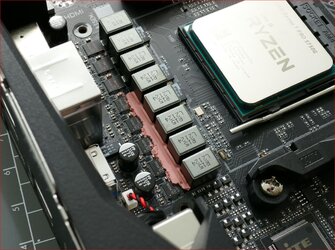- Joined
- Jan 5, 2023
I removed the wifi card as I don't need it and I don't want it and so I had to unscrew the heatsink to make that happen, that left the original soft thermal pad in pieces.
I will be reapplying the thermal pad using Thermalright Odyssey Thermal Pad 12.8 W/mK 1,5 mm, but I am not sure if leaving the pad touching the chokes is a good idea or not.
The old thermal pad is obviosuly touching the chokes.
Probably not a big deal, but I thought I'd ask.
The old thermal pad is very soft, and about 1,5 mm thick. Compressed to 0,7mm it seems.
Also, not shown is the mobo heatsink, should that heatsink be touching the chokes? Perhaps not a good idea to adding pressure sideways I am thinking.
Also, other people have commented some place that, one shouldn't cover the capacitors with the thermal pad. In the photo there seem to be one capacitor or something between the mosfets.
Also, some suggest applying thermal pad just over the mosfet chips and not along the whole length, to improve mounting pressure onto the mostfets (assuming one doesn't try press/bend the heatsink, just fastening the screws for the heatsink.
I will be reapplying the thermal pad using Thermalright Odyssey Thermal Pad 12.8 W/mK 1,5 mm, but I am not sure if leaving the pad touching the chokes is a good idea or not.
The old thermal pad is obviosuly touching the chokes.
Probably not a big deal, but I thought I'd ask.
The old thermal pad is very soft, and about 1,5 mm thick. Compressed to 0,7mm it seems.
Also, not shown is the mobo heatsink, should that heatsink be touching the chokes? Perhaps not a good idea to adding pressure sideways I am thinking.
Also, other people have commented some place that, one shouldn't cover the capacitors with the thermal pad. In the photo there seem to be one capacitor or something between the mosfets.
Also, some suggest applying thermal pad just over the mosfet chips and not along the whole length, to improve mounting pressure onto the mostfets (assuming one doesn't try press/bend the heatsink, just fastening the screws for the heatsink.
Attachments
Last edited:
